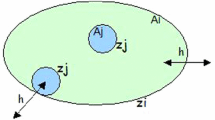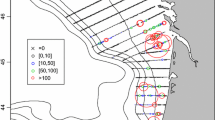Abstract
This paper presents a novel application of the geostatistical multivariate method known as min–max autocorrelation factors (MAFs) for analysing fisheries survey data in a space–time context. The method was used to map essential fish habitats and evaluate the variability in time of their occupancy. Research surveys at sea on marine fish stocks have been undertaken for several decades now. The data are time series of yearly maps of fish density, making it possible to analyse the space–time variability in fish spatial distributions. Space–time models are key to addressing conservation issues requiring the characterization of variability in habitat maps over time. Here, the variability in fisheries survey data series is decomposed in space and time to address these issues, using MAFs. MAFs were originally developed for noise removal in hyperspectral multivariate data and are obtained using a specific double principal components analysis. Here, MAFs were used to extract the most continuous spatial components that are consistent in time, together with the time series of their amplitudes. MAFs formed an empirical isofactorial model of the data, which served for kriging in each year using all available information across the data series. The approach was applied on the spawning distributions of sardine in the Bay of Biscay from 2000 to 2017. A multivariate approach for dealing with space–time data was adapted here, because the evolution in time was highly variable. Maps were classified using the amplitudes of the MAFs, and groups of typical distributions were identified, which showed different occurrence probabilities in different periods.











Similar content being viewed by others
References
Barnston A, Livezey R (1987) Classification, seasonality and persistence of low-frequency atmospheric circulation patterns. Month Weather Rev 115:1083–1126
Bellier E, Planque B, Petitgas P (2007) Historical fluctuations in spawning location of anchovy (Engraulis encrasicolus) and sardine (Sardina pilchardus) in the Bay of Biscay during 1967–73 and 2000–2004. Fish Oceanogr 16:1–15
Checkley D, Ortner P, Settle L, Cummings S (1997) A continuous, underway fish egg sampler. Fish Oceanogr 6:58–73
Desassis N, Renard D (2013) Automatic variogram modeling by iterative least squares: univariate and multivariate cases. Math Geosci 45:453–470
Dommenget D, Latif M (2002) A cautionary note on the interpretation of EOFs. J Clim 15:216–225
Doray M, Petitgas P, Romagnan J-B, Huret M, Duhamel E, Dupuy Ch, Spitz J, Authier M, Sanchez F, Berger L, Dorémus G, Bourriau P, Grellier P, Massé J (2018) The PELGAS survey: ship-based integrated monitoring of the Bay of Biscay pelagic ecosystem. Prog Oceanogr 166:15–29
Fujiwara M, Mohr M (2009) Identifying environmental signals from population abundance data using multivariate time-series analysis. Oïkos 118:1712–1720
Jennings S (2004) The ecosystem approach to fishery management: a significant step towards sustainable use of the marine environment? Mar Ecol Prog Ser 274:279–282
Morfin M, Fromentin J-M, Jadaud A, Bez N (2012) Spatio-temporal patterns of key exploited marine species in the northwestern Mediterranean sea. PLoS ONE 7(5):e37907
Petitgas P, Doray M, Huret M, Mass J, Woillez M (2014) Modelling the variability in fish spatial distributions over time with empirical orthogonal functions: anchovy in the Bay of Biscay. ICES J Mar Sci 71:2379–2389
Petitgas P, Woillez M, Doray M, Rivoirard J (2018) Indicator-based geostatistical models for mapping fish survey data. Math Geosci 50:187–208
Renard D, Bez N, Desassis N, Beucher H, Ors F, Laporte F (2014) RGeostats: the geostatistical package [version 11.1.1]. MINES ParisTech. http://rgeostats.free.fr/. Accessed 25 Aug 2017
Rivoirard J, Demange D, Freulon X, Lécureuil A, Bellot N (2013) A top-cut model for deposits with heavy-tailed grade distribution. Math Geosci 45:967–982
Rivoirard J, Freulon X, Demange C, Lecureuil A (2014) Kriging, indicators and non-linear geostatistics. J S Afr Inst Min Metall 114:1–6
Switzer P, Green A (1984) Min/max autocorrelation factors for multivariate spatial imagery. Technical report 6, Department of Statistics, Stanford University, CA
Woillez M, Rivoirard J, Petitgas P (2009) Using min/max autocorrelation factors of survey-based indicators to follow the evolution of fish stocks in time. Aquat Living Res 22:193–200
Acknowledgements
We are grateful to the crew of the research vessel Thalassa and to P. Bourriau, S. Le Mestre and M.-M. Danielou (Ifremer) for collecting the CUFES samples and identifying the sardine eggs. The work was funded in part by the European Union H2020 project CERES (Grant No. 678193 — CERES). The data were collected by Ifremer within the French national observation plan, a part of the EU fisheries data collection framework.
Author information
Authors and Affiliations
Corresponding author
Appendix: R Script to Compute MAFs on a Space–Time Data Set
Appendix: R Script to Compute MAFs on a Space–Time Data Set


Rights and permissions
About this article
Cite this article
Petitgas, P., Renard, D., Desassis, N. et al. Analysing Temporal Variability in Spatial Distributions Using Min–Max Autocorrelation Factors: Sardine Eggs in the Bay of Biscay. Math Geosci 52, 337–354 (2020). https://doi.org/10.1007/s11004-019-09845-1
Received:
Accepted:
Published:
Issue Date:
DOI: https://doi.org/10.1007/s11004-019-09845-1




